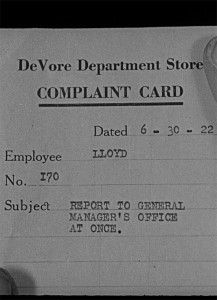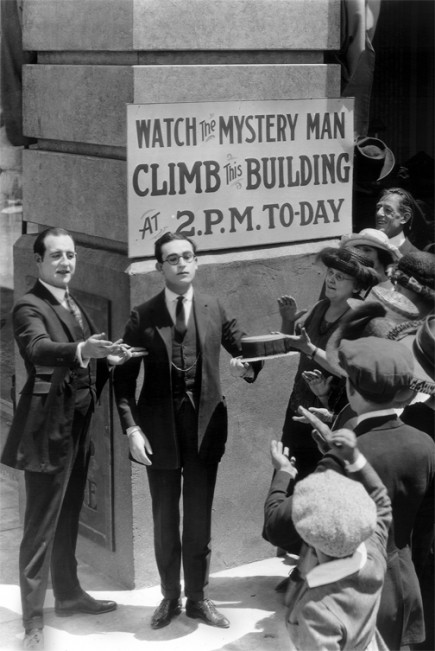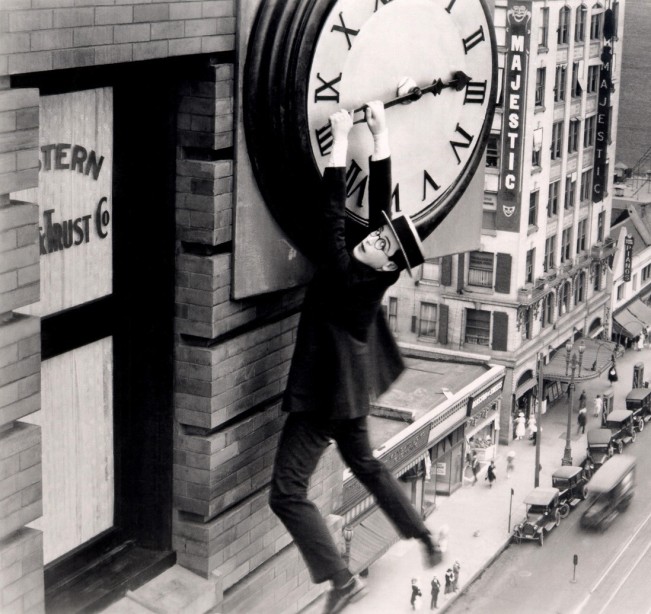

By Mike Wilmington Wilmington@moviecitynews.com
Wilmington on DVDs: Safety Last!
DVD PICK OF THE WEEK: CLASSIC
SAFETY LAST! (Blu-ray) (Four Stars)
U.S.: Fred Newmeyer, Sam Taylor, 1923 (Criterion Collection)
The sight of Jazz Age comedy icon Harold Lloyd, in Safety Last!, desperately clinging to the hands of a clock as they bend and dangle him above the street, has to be one of the imperishable images in all American movie comedy. It’s an image that keeps coming back to us generation after generation, at once hilarious and terrifying, a nightmare and an exhilarating high: with bespectacled, indefatigable Harold playing a hapless department store clerk, forced by bizarre happenstance to try to become a “human fly” (a daredevil building climber), now trapped on that clock in the upper stories of the “Bolton Building.” Wow! Scary as it seems on screen, it’s scarier still when you learn more of the story behind the movie and behind Lloyd‘s incredible stunts, some of which involved real danger, honest-to-goodness peril. Harold Lloyd: Whatta guy!
Today, in most movies, the stunts are usually CGI-manufactured: computerized visuals and technical sleight-of-hand. Lloyd’s stunts were mostly real. He really climbed a building, or at least part of it, and though he‘s mostly working on facsimiles of a building erected on the roofs of three other real ones, it’s often almost as dangerous as it looks. He really slipped and stumbled—on purpose of course—and danced on the ledges. The buildings behind him, as he clings to the wall, are not rear projection or process shots, but the real buildings of a real Los Angeles that you can see right over his shoulder. If he’d fallen, he might have been severely injured. And, in many cases, the only thing between Lloyd and a plunge to the street below was a platform with mattresses positioned beneath him—a “safety” device that ultimately proved not so safe and not so reliable.
So it was in the Golden Age of silent movie comedy—especially for great filmmakers like Buster Keaton, like Charlie Chaplin—and for Harold Lloyd, the master of the thrill comedy.
With his ever-present spectacles, everyday suit, jaunty straw hat and his harried expression, which often broke into a dazzling smile, Lloyd, or “Harold” (or “The Boy”), as he was variously known in his films, was the most normal-looking, the least “outside,” of the three prime movie clowns of the ‘20s. Charlie was a gentleman tramp, Buster was either a shy small town lad or a foppish rich guy. But Harold was the all-American boy whom you might bump into on the street—the go-getter, always trying to get ahead, get the job, get the touchdown, get the girl. He was Mr. Average Joe and Mr. U.S.A.: The Climber.
In Safety Last!, his most brilliant and flabbergasting cinematic feat, Harold is a small town boy (called, simply, “The Boy”), who, migrating and working in the big city, and wanting to impress his girl (called “The Girl”) back home (played by Mildred Davis, Lloyd‘s wife), begins to fib a little. Harold is merely a put-upon clerk at the DeVore Department Store, the target of a sadistic floorwalker named Stubbs (Westcott P. Clarke), but in his letters, he‘s been sending Mildred glowing (and false) reports of his steady climb to the top, and his (fictitious) recent promotions.
 This first part of Safety Last!, the set-up, is good enough to be a little classic all by itself—a wonderful satire of the classic American success story. Lloyd paints The Boy‘s predicament, the tower of lies and exaggerations he erects. Then he shows how—when Mildred comes to the city and pays him a visit at the store—Harold, who is afraid of ’fessing up, tries to continue the deception by posing as his own boss and breathlessly racing himself and Mildred in and out of the manager’s office. Later, trying to get in good with his perplexed superiors, he comes up with a promotional scheme he thinks will make a hit: an exhibition in which his pal “Limpy” Bill, a local “human fly” (played by real-life climber Bill Strother) will scale, by hand, all 12 floors of the (fictitious) Bolton Building which houses the DeVore Store.
This first part of Safety Last!, the set-up, is good enough to be a little classic all by itself—a wonderful satire of the classic American success story. Lloyd paints The Boy‘s predicament, the tower of lies and exaggerations he erects. Then he shows how—when Mildred comes to the city and pays him a visit at the store—Harold, who is afraid of ’fessing up, tries to continue the deception by posing as his own boss and breathlessly racing himself and Mildred in and out of the manager’s office. Later, trying to get in good with his perplexed superiors, he comes up with a promotional scheme he thinks will make a hit: an exhibition in which his pal “Limpy” Bill, a local “human fly” (played by real-life climber Bill Strother) will scale, by hand, all 12 floors of the (fictitious) Bolton Building which houses the DeVore Store.
Unfortunately, Harold and Bill have angered a local cop (Noah Young) the day before, and the cop is on the prowl. To protect Bill, Harold agrees to start the climb himself, and then, surreptitiously, let Bill take his place on an upper floor, to complete the ascent. This cop, though, keeps pursuing Bill from floor to floor, always arriving at the moment when the boys are about to make the switch, and thus sending Bill racing off (assuring Harold he‘ll “ditch the cop,”) and Harold climbing to another floor.
Up and up poor, inexperienced Harold climbs. Further and further below lies the street. The cop refuses to get ditched. Each floor brings a new complication or danger, including a phony gun, a mouse up Harold’s pants leg, interfering pigeons and that unforgettable collapsing clock. Soon, it looks as if Harold may have to climb up the side of the entire building, while below, the awestruck crowd oooooohs and aaaaaahs and yells and cheers, and beyond them, the movie audience, which never fails to be mesmerized by Safety Last! and Harold‘s climb, is doing the same.
Harold Lloyd was F. Scott Fitzgerald‘s favorite movie comedian, and it‘s easy to see why. Lloyd had a trajectory not unlike the “Harold” of his movies, or like Jay Gatsby’s. He was a small town boy from Nebraska and Colorado, who came to L. A. and hooked up with acting pal and eventual studio head Hal Roach to rise and climb and become a Hollywood box-office king, and one of the richest men in town. Harold Lloyd: Whatta guy!
 Lloyd called his special brand of cliffhanger comedies—in which an ordinary guy somehow winds up walking the girders of a skyscraper under construction, or stumbling into a revolution, or dancing on a building ledge or dangling from a broken clock—“thrill comedies.” He invented the form and nobody did it better—not even, decades later, Lloyd’s great admirer, the fabulous Hong Kong acrobat-stuntman-actor Jackie Chan. Safety Last! perfected the form—which Lloyd had also used in High and Dizzy and Never Weaken and Look Out Below, and would use again in Feet First—and set the template. Audiences loved it, and still do.
Lloyd called his special brand of cliffhanger comedies—in which an ordinary guy somehow winds up walking the girders of a skyscraper under construction, or stumbling into a revolution, or dancing on a building ledge or dangling from a broken clock—“thrill comedies.” He invented the form and nobody did it better—not even, decades later, Lloyd’s great admirer, the fabulous Hong Kong acrobat-stuntman-actor Jackie Chan. Safety Last! perfected the form—which Lloyd had also used in High and Dizzy and Never Weaken and Look Out Below, and would use again in Feet First—and set the template. Audiences loved it, and still do.
These thrill comedies, of course, can be viewed symbolically. Harold the rising young man in his pictures, is the young ambitious American go-getter trying to get ahead. And, to climb his way to the top of the world of business or life, he has to brave (albeit sometimes unwittingly), the perils of business and life. The perfect symbol of that rise is Harold gamely climbing up the Bolton Building, daring the heights, meeting insane new obstacles on every floor. That’s life. That’s showbiz. Sometimes you make it all the way up (like Lloyd or Chaplin). Sometimes you get there and fall (like Keaton). But the danger, the thrill, is always there.
Four years before he made Safety Last!, for example, in Lloyd’s comedy short Haunted Spooks, a bomb gag with a supposedly dummy bomb went awry and the live explosive blew off Lloyd’s thumb, his forefinger, and left his right hand partly paralyzed—for which he compensated with prosthetics and a special glove. When Harold performed all the amazing stunts in Safety Last! and other pictures, some of the most amazing comic stunts in cinema history, he was a man with only one good hand—or, to be more accurate, a man (and an artist) with two great hands, one of which just happened to be missing a finger and a thumb.
Lloyd never took directorial credit on his movies. That usually went to people like Fred Newmeyer and Sam Taylor here. (The writing team on Safety Last! included Roach, Taylor, Tim Whelan and Lloyd.) But if ever an actor was the auteur of his movies, it was Harold Lloyd. He planned and executed the stunts; he structured the stories, he created the character, He was the go-getter, the boy, the guy with the glasses, the man who stopped time and dangled from its hands. He was a genius and an athlete, and he excelled at playing ordinary Joes in extraordinary pickles. He was one actor who didn’t leave all the risky stuff to the stunt men.
We mentioned that on the Safety Last! climb, there was no safety net, but only that mattress platform for protection. Protection? During the shoot, somebody dropped a dummy on the mattresses and the dummy bounced off and fell to the street or roof below. Now Harold Lloyd was no fool. He must have been pretty damned sure he wasn‘t going to slip on any of his epic stunts. And he didn’t. Harold Lloyd: Whatta guy!
Extras: An unusually excellent package, including two musical scores for Safety Last!, one with orchestra by Carl Davis and one by organist Gaylord Carter; Commentary by Leonard Maltin and Richard Correll; Introduction by Suzanne Lloyd, Harold’s granddaughter and the president of Harold Lloyd Entertainment; Documentary Harold Lloyd: The Third Genius (1989) (three stars), narrated by Lindsay Anderson; Three newly restored Harold Lloyd short comedies by Hal Roach (all three stars), Take a Chance (1918), Young Mr. Jazz (1919), and His Royal Slyness (1920), with commentary by Correll and John Bengston; Documentary Locations and Effects, with Bengston and Craig Barron; Interview with Carl Davis; Booklet with a keen-o essay by Ed Park.














